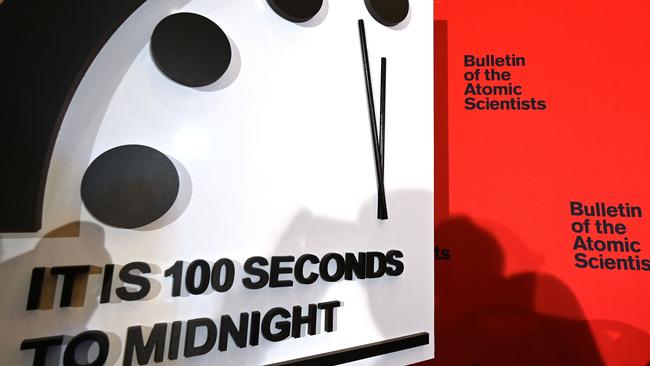Doomsday Clock moves closest to midnight in 73-year history
Nuclear war, climate change sees symbolic countdown to global disaster inch to closest point to midnight in its 73-year history.

The keepers of the Doomsday Clock have moved the symbolic countdown to global disaster to the closest point to midnight in its 73-year history, citing “existential danger” from nuclear war and climate change.
The Bulletin of the Atomic Scientists, which was founded after the creation of the atomic bomb in World War II and focuses on the greatest threats to human survival, said it moved the clock from two minutes to midnight to 100 seconds to midnight — a 20-second advance.
“Today the Bulletin of the Atomic Scientists moves the hands of the Doomsday Clock. It is 100 Seconds to Midnight,†— @RachelBronson1, President & CEO, Bulletin of the Atomic Scientists#DoomsdayClock pic.twitter.com/bxlf9TvEZu
— Bulletin of the Atomic Scientists (@BulletinAtomic) January 23, 2020
The decision was made by the group’s science and security board, in consultations with its board of sponsors, which includes 13 Nobel laureates.
In a statement accompanying the clock’s advance, the organisation said the nuclear and climate dangers were “compounded by a threat multiplier, cyber-enabled information warfare that undercuts society’s ability to respond.”
“The international security situation is dire, not just because these threats exist, but because world leaders have allowed the international political infrastructure for managing them to erode,” it said.
“The world is sleepwalking its way through a newly unstable nuclear landscape. The arms control boundaries that helped prevent nuclear catastrophe for the last half century are being steadily dismantled.â€
— Bulletin of the Atomic Scientists (@BulletinAtomic) January 23, 2020
Read the full #DoomsdayClock statement: https://t.co/w3aOZ3dO2J pic.twitter.com/ZbSM72ZncP
Rachel Bronson, president and CEO of the Bulletin of the Atomic Scientists, said: “We are now expressing how close the world is to catastrophe in seconds — not hours, or even minutes. We now face a true emergency — an absolutely unacceptable state of world affairs that has eliminated any margin for error or further delay.”
“Civilization-ending nuclear war—whether started by design, blunder, or simple miscommunication—is a genuine possibility. Climate change that could devastate the planet is undeniably happening.†Read the full #DoomsdayClock statement: https://t.co/w3aOZ3dO2J pic.twitter.com/OajqCxYQqA
— Bulletin of the Atomic Scientists (@BulletinAtomic) January 23, 2020
Former California Governor Jerry Brown, the Bulletin’s executive chairman, warned that “dangerous rivalry and hostility among the superpowers increases the likelihood of nuclear blunder.”
“Climate change just compounds the crisis,” he said. “If there’s ever a time to wake up, it’s now.”
“Public awareness of the climate crisis grew over the course of 2019, largely because of mass protests by young people around the world. Just the same, governmental action on climate change still falls far short of meeting the challenge at hand.†#DoomsdayClock pic.twitter.com/WkwjlJuVTw
— Bulletin of the Atomic Scientists (@BulletinAtomic) January 23, 2020
The Doomsday Clock didn’t move in 2019 but in 2018 it advanced by 30 seconds to two minutes to midnight.
As the symbolic clock was moved this morning (AEDT), the Bulletin’s experts were joined by former Irish President Mary Robinson who now leads The Elders, a group of prominent former world leaders founded by Nelson Mandela, and ex-UN Secretary-General Ban Ki-moon, now deputy chairman of The Elders.
Ban said that from the US withdrawal from the 2015 Paris climate agreement and the Iran nuclear deal to deadlock at nuclear disarmament talks and divisions in the U.N. Security Council, “our mechanisms for collaboration are being undermined when we need them most.” Robinson called on world leaders to join in working “to pull humanity back from the brink.”
AP



To join the conversation, please log in. Don't have an account? Register
Join the conversation, you are commenting as Logout